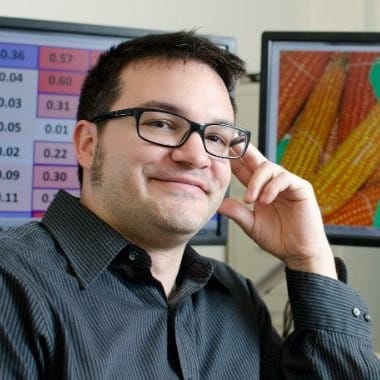Radical collaborations were essential to advancing DNA sequencing technology, to where it now costs about $100 to re-sequence the human genome. This has resulted in a deluge of low-cost genomic data.
In contrast, phenotyping is a 10,000-year-old challenge that started with the visual assessment of plants for desirable attributes at the time of plant domestication. Phenomics technologies have only just begun to evolve more rapidly, and phenomics data are typically more expensive to collect data on a large scale than their genomic counterparts.

This has caused a massive imbalance in the volume of data collected, says Michael Gore, international professor of plant breeding and genetics at Cornell University. Gore spoke today at the National Association of Plant Breeders (NAPB) virtual meeting as part of a session on high-throughput phenotyping and the promise it holds for bolstering crop production.
The concept of field-based high throughput phenotyping has been advocated by those like Gore in the plant breeding community to reduce human effort, collect higher amounts of data, evaluate large population sizes at many time points in a growing season, decrease subjectivity when scoring plants, and diminish phenotyping costs over time.
“Radical collaborations among plant biologists, engineers and computer scientists are needed to bring the lab to the field, allowing multi-scale data to be collected,” he says.
Gore’s lab combines quantitative genetics, genomics, analytical chemistry and remote sensing to elucidate the genetic basis of complex trait variation in various crops, including maize, oat, cassava, cotton, sorghum, industrial rapeseed and guayule.
Gore’s team began collaborating in 2010 with agricultural engineers at the University of Arizona, implementing a rapid phenotyping platform to monitor changes in phenotypes at multiple time points within a day and multiple days across the growing season in cotton. The goal, as explained on the Gore lab website, is to understand the pattern of QTL expression dynamics under varying environmental conditions and more specifically, what QTL may be important in mitigating the consequences of heat and drought stresses.
Furthermore, research continues on the development of proximal sensing techniques and analysis of this type of data as it relates to resolving the genetic basis of important physiological, fiber quality, and agronomic traits, according to the site.
Shifting focus from the round to the sky, Gore’s team has assessed the potential use of unmanned aerial vehicles (UAVs) as efficient co-workers for precisely monitoring the incidence and severity of the northern leaf blight pathogen in maize.
Through a collaboration with Hod Lipson (Columbia University) and Rebecca Nelson (Cornell University), Gore’s team is using aerial imagery collected via small UAVs in combination with deep learning to recognize leaf blight symptoms in plant images. The ultimate goal is to develop a semi-autonomous system that can identify and quantify levels of NLB and other potential plant diseases in the field.









